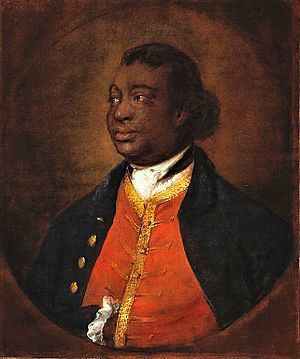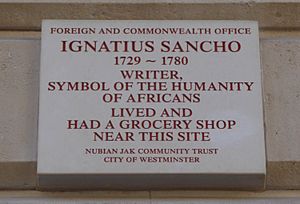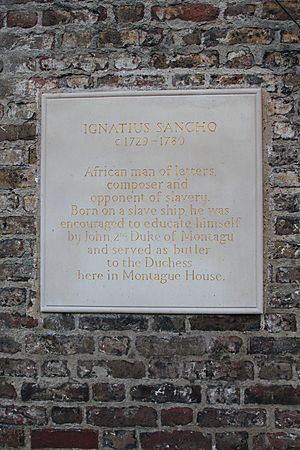Ignatius Sancho facts for kids
Quick facts for kids
Ignatius Sancho
|
|
|---|---|

Portrait of Sancho, c. 1768, by Thomas Gainsborough
|
|
| Born |
Charles Ignatius Sancho
c. 1729 |
| Died | 14 December 1780 (aged 50–51) |
| Occupation | Composer, writer, shopkeeper |
| Known for | First person of African descent to vote in a British general election; influence on abolitionism |
| Spouse(s) | Anne Osborne |
| Children | Frances Joanna (1761–1815), Ann Alice (1763–1805), Elizabeth Bruce (1766–1837), Jonathan William (1768–1770), Lydia (1771–1776), Katherine Margaret (1773–1779), William Leach Osborne (1775–1810) |
| Signature | |
Charles Ignatius Sancho (born around c. 1729 – died 14 December 1780) was a very important British abolitionist, writer, and composer. He was born on a slave ship in the Atlantic Ocean. Sadly, he was sold into slavery in a Spanish colony called New Granada.
After his parents died, Sancho, who was only two years old, was brought to Britain. He was given to three sisters in Greenwich and lived with them for 18 years. He didn't like being a servant there, so he ran away. He went to Montagu House, Blackheath where John Montagu, 2nd Duke of Montagu taught him to read. The Duke also encouraged Sancho's love for books.
Sancho worked as a butler for a while. Later, he opened his own shop as a shopkeeper. He also started writing and publishing essays, plays, and music. Sancho quickly became involved in the movement to end slavery in Britain. He was one of its strongest supporters. Because he was a male property-owner, he could legally vote in elections. He voted in 1774 and 1780, becoming the first known British African to vote in Britain.
People in Britain called him "the extraordinary Negro." For those who wanted to end slavery, Sancho showed that African people were just as human as anyone else. He proved how wrong the slave trade was. Sancho died in 1780. Two years later, his letters were published in a book called The Letters of the Late Ignatius Sancho, an African. This was the first collection of letters published by a writer of African descent.
Contents
Early Life and Freedom
Charles Ignatius Sancho was born on a slave ship. This ship was crossing the Atlantic Ocean during a terrible journey called the Middle Passage. His mother died soon after they arrived in the Spanish colony of Viceroyalty of New Granada. This area is now parts of Colombia, Ecuador, Panama, and Venezuela. His father reportedly took his own life rather than live as a slave.
Sancho was only two years old when his owner took him to England. He was given to three unmarried sisters in Greenwich. He lived with them from 1731 to 1749. The Duke of Montagu often visited the sisters. He was very impressed by Sancho's intelligence and friendly nature. The Duke encouraged Sancho to read. He also lent him books from his own library at Blackheath.
Life in Britain
Sancho's learning made him feel trapped at Greenwich. So, in 1749, he ran away to Montagu House, Blackheath. For two years, he worked as a butler for the Duchess of Montagu. He spent his time enjoying music, poetry, reading, and writing. When the Duchess died in 1751, Sancho received some money and a year's salary.
On 17 December 1758, he married Anne Osborne, a woman from the West Indies. He became a loving husband and father. They had seven children: Frances Joanna, Ann Alice, Elizabeth Bruce, Jonathan William, Lydia, Katherine Margaret, and William Leach Osborne. Around the time their third child was born, Sancho became a valet for George Montagu. This was the son-in-law of his previous boss. Sancho worked as a valet until 1773.
In 1768, the famous British artist Thomas Gainsborough painted a portrait of Sancho. By the late 1760s, Sancho was well-known and respected. In 1766, when people were debating slavery, Sancho wrote to the writer Laurence Sterne. He asked Sterne to speak out against the slave trade. Sterne's reply to Sancho's letter became a very important part of the fight against slavery in the 1700s.
After these letters were published, Sancho became famous as a man of letters. He was a British citizen and a voter. Even though he had lived in Britain since he was two, he felt like "only a lodger."
Shopkeeper and Public Figure
In 1774, Sancho was not well and suffered from gout. With help from Montagu, he opened a grocery shop. It was at 19 Charles Street in London's Mayfair. He sold things like tobacco, sugar, and tea. These goods were often made by slaves in the West Indies.
As a shopkeeper, Sancho had more time to meet friends and write letters. His shop had many visitors. He wrote a Theory of Music, but no copies exist today. Sancho composed 62 known pieces of music. These were printed in London between c. 1767 and 1779. He also wrote two plays.
Because he owned a home and had money, he could vote in the elections of 1774 and 1780. He was the first person of African origin known to vote in Britain. At this time, he also wrote letters and newspaper articles. Sometimes he used his own name, and sometimes he used the name "Africanus."
Sancho knew many famous people. These included the artist Thomas Gainsborough and the actor David Garrick. The politician Charles James Fox also visited his shop. Fox worked to end the slave trade.
Death and Published Letters
Ignatius Sancho died on 14 December 1780 from gout. He was buried in the churchyard of St Margaret's, Westminster. There is no special memorial for him there. He was the first person of African descent to have an obituary (a notice of death) in the British press.

Sancho's letters often talked about daily life. But they also shared his thoughts on politics and literature in 18th-century Britain. One famous set of letters describes the Gordon Riots in June 1780. An angry mob passed by his shop on Charles Street. These riots started as a protest against rights for Roman Catholics. They grew into a violent mob that looted and burned parts of London.
In 1782, Frances Crewe, one of Sancho's friends, arranged for 160 of his letters to be published. They were in two books called The Letters of the Late Ignatius Sancho, an African. The book sold very well, with over 2,000 people buying it. His wife received more than £500 from the sales. Four more editions of the book were printed by 1803.
Sancho's son, William Leach Osborne Sancho, took over the shop. He turned it into a printing and book-selling business. In 1803, he printed a fifth edition of his father's letters.
Sancho was very direct in his letters. In one, he wrote: "I am Sir an Affrican – with two ffs – if you please – & proud am I to be of a country that knows no politicians – nor lawyers – nor [word deleted] ... nor thieves of any denomination save Natural...." This was his response to a letter from Jack Wingrave, who had negative views about people of color.
Legacy

- A plaque honoring Sancho was put up on 15 June 2007. It is on a remaining wall of Montagu House in Greenwich Park. This plaque celebrates 200 years since the Slave Trade Act 1807 became law. Another plaque is on the Foreign and Commonwealth Office building.
- The City of Westminster created a walking tour to remember those who fought to end the slave trade. They included 19 Charles Street, where Sancho's shop was.
- Sancho was honored on a 2007 postage stamp by the Royal Mail. This was to recognize his work as an abolitionist.
- Sancho is on the list of "100 Great Black Britons."
- A painting called Portrait of an African (from around 1757–59) is probably of Sancho. It was once thought to be of Olaudah Equiano. It is now believed to be by Allan Ramsay.
- In 2015, a play about Sancho's life, called Sancho: An Act of Remembrance, was performed. It was written and performed by Paterson Joseph. The play was staged in Oxford, Birmingham, and New York. It came to London in 2018. Sancho is also the main character in Joseph's 2022 novel, The Secret Diaries of Charles Ignacius Sancho.
- On 1 October 2020, Google honored Sancho with a Google Doodle for British Black History Month.
See also
- Black British elite, the group Sancho was part of
- Joseph Antonio Emidy, another early Black English composer (1775–1835)
- George Bridgetower, a talented violinist (1778–1860)
- Samuel Coleridge-Taylor, a famous Black English composer (1875–1912)
- List of slaves


